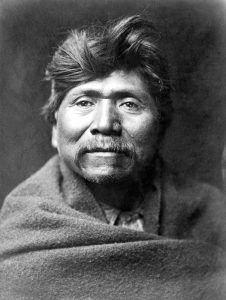The Hualapai tribe, also spelled Walapai, meaning “People of the Tall Pine,” have lived along the Colorado River and the Grand Canyon of Arizona for centuries.
The Hualapai are descendants of the “Pai,” whose earliest physical remains have been found along the Willow Beach bank near the Hoover Dam, dating back as early as 600 A.D. 600. They are close relatives to the Yavapai and with Paipai of northern Baja California.
Traditional hunters and gatherers, they also grew corn, beans, melons, and squash. Living in dome-shaped houses built with juniper branches, they were first discovered by Spanish explorers in the 1500s.
In 1857, Edward Beale carved a wagon road from Fort Defiance to the Colorado River, on the border between Arizona and California. The path cuts right through Hualapai territory. In 1863, gold was discovered in the Prescott Valley and the gold rush brought a steady flow of miners and other settlers to the area. The following year, a toll road was built through Hualapai territory between Prescott and Bull Head City. Like other tribes, the Hualapai were disturbed by increased settler traffic upon their lands, but relations between them and the new settlers were generally peaceful until April 1865. Afterward, the Indians were involved in the Hualapai War, from 1865 to 1870, as a result of encroaching settlers upon their lands.
The Hualapai continued to resist the advance of the Americans but were defeated in 1874 after being starved out in Meriwitica Canyon and deported to La Paz, south of Parker, Arizona. However, this reservation was not suitable and many died, so a new reservation was established by presidential executive order in 1883, at which time, the tribe numbered around 700.
Today, the Hualapai live on a reservation encompassing a million acres along 108 miles of the Colorado River and the Grand Canyon. Their tribal capital is located at Peach Springs, Arizona, with a total population of some 1,600 members. Their economy is based on tourism, river-rafting, cattle-ranching, hunting expeditions, and timber-cutting, as well as crafting of traditional and modern folk arts.
In recent years, Peach Springs has seen a large comeback, due to the promotions of the Hualapai tribe and their exclusive access to one of the last undeveloped sections of the Grand Canyon. Visitors can tour the Grand Canyon West Rim on the Hualapai Reservation, stay at the Hualapai Lodge in Peach Springs, visit an authentic Native American village, and take a walk on the well-known Grand Canyon Skywalk — a glass bridge that juts out across the canyon, providing views some 4,000 feet down to the canyon floor.
The Hualapai Tribe is a sovereign nation and governed by an executive and judicial branch and a tribal council. The tribe provides a variety of social, cultural, educational, and economic services to its members.
More Information:
Hualapai Tribe
P.O. Box 179
941 Hualapai Way
Peach Springs, Arizona 86434
928-769-2216
© Kathy Weiser-Alexander/Legends of America, updated November 2021.
Also See:
Sources:


